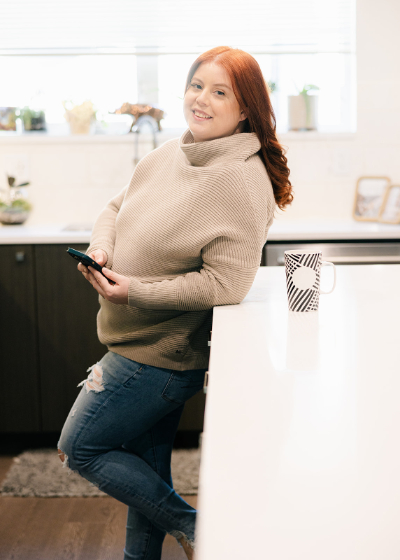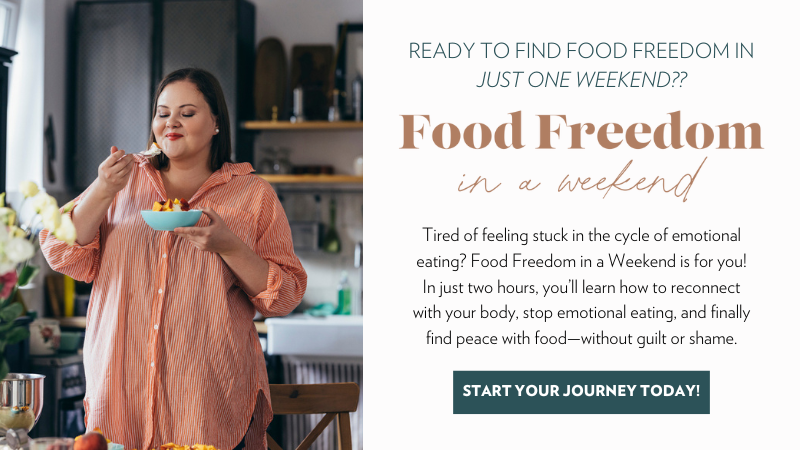hen it comes to food struggles, the line between disordered eating vs eating disorder isn’t always clear. You might not see yourself in the extreme stories that make headlines—but still find food taking up far too much space in your mind. Maybe you’re always planning your next “reset,” feeling guilty after certain meals, or swinging between strict rules and feeling out of control.
The truth is, harmful eating patterns don’t have to meet a clinical diagnosis to impact your life in a big way. In fact, many women live for years in that “in-between” space, convinced they’re just not disciplined enough—when what’s really going on is far more complex, and far more common.
Hi, I’m Dr. Meredith MacKenzie, and my work centres on helping women untangle themselves from the grip of diet culture. As a binge eating therapist and intuitive eating coach, through my One Body to Love program, I guide clients who are tired of white-knuckling their way through food rules and still feeling like they’re “failing.” I know how exhausting it is to plan every bite, dread your own reflection, or feel like your appetite is something that needs controlling. My approach blends evidence-based therapy with practical tools to rebuild body trust, so food can take its rightful place as one part of your life, not the centre of it. If you’re ready for honest, stigma-free conversations about food freedom and self-worth, join me on Instagram.

When “Healthy Eating” Becomes a Full-Time Job: Anna’s Story
Let me tell you about a client of mine—we’ll call her Anna. Anna had never been diagnosed with an eating disorder. She had a stable job, a family, and a regular routine. But food quietly ran her life. She was always either thinking about what she should be eating, regretting what she’d just eaten, or planning her next attempt to “get it under control.”
Anna genuinely believed she was the problem. She thought there was some secret formula everyone else had mastered—a perfect combination of rules, timing, and willpower that made eating feel effortless. To her, everyone else seemed able to cut out foods, track every bite, and stay disciplined without struggle. So why wasn’t it easy for her?
That belief bred shame. Her days revolved around food rules, workout timing, and “earning” meals. If she deviated even slightly, the spiral began: Why can’t I just get it right?
The stress was relentless. Food wasn’t nourishing—it was a mental burden she carried everywhere.
When we started working together, Anna realized what she was experiencing had a name: disordered eating. Understanding the difference between disordered eating vs eating disorder became her first step toward healing.
Listen to this Episode Now
Disordered Eating vs Eating Disorder: Understanding the Spectrum
Eating behaviours exist on a spectrum. On one side, there’s intuitive eating and joyful movement, where food is simply food, and movement is chosen for pleasure, not punishment. On the other, there are clinical eating disorders like anorexia, bulimia, and binge eating disorder.
But in between? That’s where so many women live. And because it’s so common, it often feels “normal.” This is the world of yo-yo dieting, clean eating, cheat meals, intermittent fasting, and guilt-driven workouts.
When your peace is constantly disrupted by food rules and shame, that’s not discipline; that’s disordered eating.
Curious whether this is tipping toward a clinical eating disorder? This post walks through the signs to watch.
How Disordered Eating Shows Up in Everyday Life
As a binge eating therapist, I see the same patterns over and over:
- Skipping meals to “save up” for later
- Exercising only to burn calories
- Feeling out of control around certain foods
- Creating strict food rules that feel non-negotiable
- Cutting entire food groups because they’re “bad”
- Labelling foods as “good” or “bad”
- Planning life around eating and workouts
- Guilt when you “break” your rules
- Eating to cope emotionally without knowing why


If these patterns sound familiar, you’re not imagining it – this post will help you see how diet culture hides in plain sight.
The problem? We’ve normalized disordered eating and called it wellness. When friends bring “safe” meals to events, talk about earning food after workouts, or skip meals for weight loss, it’s harder to see that these habits can be harmful. If even snacks spark guilt or a sense of being lost in rules, here’s a compassionate guide to reclaiming peace with food.
You don’t have to wait for things to get “bad enough” to deserve support. You’re worthy of healing the moment you recognize that food is taking more from you than it’s giving.
What Is an Eating Disorder?
Eating disorders are recognized mental health diagnoses with specific clinical criteria. They can involve extreme food restriction, purging, binge eating, or obsessive thoughts about body size and shape.
What many people don’t realize is that eating disorders often begin with disordered eating. And sometimes, the behaviours don’t look that different at first glance. The difference is usually in their intensity, frequency, and the way they disrupt your daily life.
Disordered Eating vs Eating Disorder: A Binge Eating Example
Let’s take binge eating as an example. In disordered eating, a person might occasionally eat past fullness – often after restriction or stress. In binge eating disorder, this happens regularly, feels uncontrollable, and is often followed by deep shame.
The DSM-5-TR outlines binge eating disorder with criteria including:
- Recurrent episodes of eating unusually large amounts in a short time with a sense of lost control
- At least three behaviours, such as eating rapidly, until uncomfortably full, when not hungry, alone due to embarrassment, or with intense guilt afterward
- Marked distress about binge eating
- Occurs at least once a week for three months
- Not tied to purging or another eating disorder
Both disordered eating and eating disorders can be deeply harmful. The difference isn’t always in the action – it’s in the level of distress, disruption, and disconnection they cause.

Reflection Prompt: Is Food Taking More Than It’s Giving?
Take a moment and ask yourself:
- Do I ever feel like I can’t stop eating once I start?
- Have I eaten in secret because I felt embarrassed?
- Do I feel deep guilt or shame after eating, especially larger amounts?
- Am I often physically uncomfortable after eating?
Answering “yes” to any of these doesn’t mean something is wrong with you, it means your relationship with food deserves care and attention. These are valid, real experiences. And you don’t have to navigate them on your own.
The difference isn’t just in the behaviour, it’s in how much it disrupts your life.
People with eating disorders might:
- Avoid social situations that involve food
- Exercise despite being sick or injured
- Experience severe anxiety around eating or body image
- Hide eating habits because of shame

Why Disordered Eating Often Gets Missed
One of the biggest reasons disordered eating flies under the radar is that we’re surrounded by diet culture. It normalizes restriction, obsession, and guilt. In fact, if you’re in a larger body, the same behaviours that harm your mental and physical health might even be praised.
Government-funded programs are stretched thin and often serve only the most acute cases—people who meet strict diagnostic criteria for an eating disorder. The message this sends? Unless you’re “sick enough,” you don’t qualify for help.
Our system makes people feel like they have to struggle more before they can get support. That’s not okay.
Here’s the truth: if your relationship with food or your body is making life harder, it matters. You don’t have to wait for it to reach a crisis point to seek support.
Taking the Next Step: Support for Disordered Eating vs Eating Disorder
If your thoughts about food and your body are stealing your peace, joy, or presence in life, that’s enough reason to take action. You haven’t failed – diet culture has failed you. Inside One Body to Love, we support women at every point on the spectrum, from those just starting to notice the signs of disordered eating to those who have been in the cycle for years. You are not too far gone, and you don’t have to navigate this alone.
If you want a short, impactful way to begin, my Food Freedom in a Weekend mini-course is a powerful first step toward making peace with food—without guilt, rules, or restriction.
And if you’d like to explore this topic more deeply, listen to my One Body to Love podcast episode where I unpack the difference between disordered eating and eating disorders, why it often gets overlooked, and how to know when it’s time for support.
Links Mentioned:
- Join One Body to Love Program
- Enroll in Food Freedom in a Weekend
- Come say “Hi” on Instagram
- Listen to the One Body to Love Podcast